Your mind and body have a powerful connection. What you think can affect how you feel and how you feel can affect your mind. It’s hard sometimes to feel good when you have chronic pain or fibromyalgia. In this blog I will write about some of the techniques and devices for improving your mind body wellness with autogenic training, biofeedback, and mindfulness meditation reviewed in part 1, and neuroacoustic conditioning, and neurofeedback meditation in this part 2.
Disclaimer – The views expressed in this blog belong solely to the author and do not provide health care advice. Always seek the advice of your physician or other qualified health provider with any questions you may have regarding a medical condition. The author is not affiliated in any way with the companies and devices mentioned in this blog.
1. Neuroacoustic conditioning
Neuroacoustics is a form of audio therapy using neuroscience technology to help provide physiological and psychological effects.
Binaural beats is one approach to provide neuroacoustics conditioning (attempt to help regulate particular brainwave frequencies). Binaural beats are when one frequency is played in one ear and another frequency is played in the other ear through headphones or earbuds. The brain will hear a third frequency from the interference which is a delta of the two tones. For example, if a 500 Hz pure tone is presented in the right ear, while a 400 Hz pure tone is presented in the left ear, the listener will perceive the auditory illusion of a third tone at 100 Hz (500-400). This third tone is the binaural beat.
“Binaural-beat perception originates in the inferior colliculus of the midbrain and the superior olivary complex of the brainstem, where auditory signals from each ear are integrated and precipitate electrical impulses along neural pathways through the reticular formation up the midbrain to the thalamus, auditory cortex, and other cortical regions.” Oster, et al.
Some potential benefits of binaural beats therapy may include: reduced stress, reduced anxiety, increased focus, increased concentration, increased motivation, increased confidence, and deeper meditation.
One study, evaluated the use of binaural beats with a delta embedded music program to help with sleep in fibromyalgia. The results found an improvement on tiredness upon awakening, but no significant improvement in pain level. There were no adverse events.
NuCalm provides neuroacoustics to improve sleep and resolve stress. The patented technology also uses a biosignal processing disc that signals the body to initiate the NuCalm relaxation process, which counteracts the damaging effect of adrenaline and cortisol. The discs are provided in an electrostatic bag as they are activated by the body’s own electromagnetic field to stimulate the reproduction, release, and absorption of GABA (neurotransmitter that counteracts adrenaline and cortisol).
NuCalm is not meant to be a meditation substitute according to the founder, but it is very easy to use for those that haven’t meditated in the past. The session is designed to allow the “monkey mind” to continue while using the neuroacoustics to work, reducing brainwaves to lower more calming ones. This is a subscription based service and pricing is based on the number of discs. See Figure 1. for an image of the biosignal processing discs and eye patch.
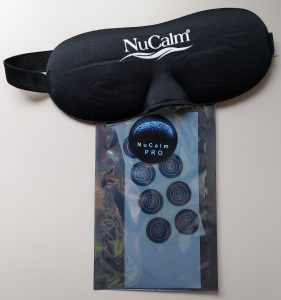
Figure 1. NuCalm Discs and Eye Cover
I find NuCalm helpful after a night without much sleep to recover and it is probably also very beneficial for jet lag. I can feel a slight tingling sensation at the disc during a session. There are a few reviews for NuCalm on YouTube. One review is at the following link: https://www.youtube.com/watch?v=vJyEmo0ygac
The Sensate Pebble also falls into this category of neuroacoustic conditioning with the addition of the Pebble vibrations to the music. This device was discussed in the sleep blog. It is likely the music uses binaural beats in addition to coordination with the Pebble vibrations. From their website is the following statement:
“The infrasound vibrations from Sensate are very carefully orchestrated with the audible music you hear in the headphones. Our S.I.R.T. ™ (Sensate Infrasound Resonance Technology) unites your Sensate and the app in one harmonious soundscape that is not possible to reproduce by playing ‘regular’ tracks.”
Both the NuCalm and Sensate are good for calming the nervous system for those that haven’t meditated before. After I had a poor night’s sleep I used the NuCalm Rescue for 50 minutes and later that morning I used the Sensate Pebble Nebula for 30 minutes. During these sessions I used the Oura ring moments to capture what my heart rate and HRV were doing. In both sessions, I had reduced heart rate and increased HRV compared to the night baseline as shown in Figure 2. So from this, I think both were effective. Although the Sensate trial was building on the restoration of the NuCalm session, and it was only one trial, it was slightly more effective in a shorter time frame. Hopefully I won’t have too many of these bad night sleeps! I have also found the Sensate Pebble Nebula track very effective for treating headaches.
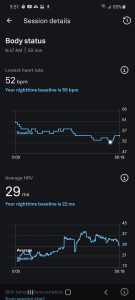
After NuCalm Rescue 50 minutes 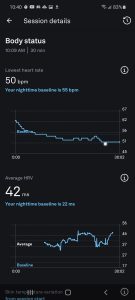
After Sensate Nebula 30 minutes
Figure 2. Comparison of NuCalm and Sensate sessions after poor nights sleep
2. Neurofeedback meditation
Neurofeedback is a type of biofeedback that uses brain activity to self-regulate the brainwaves. The sensors used in the devices are typically electroencephalography (EEG) sensors to measure the electrical activity on the head. Neurofeedback therapy has typically been conducted in a medical facility or clinic with a trained therapist, but today there are new wearables on the market for home use.
Neurofeedback devices typically provide visible or auditory feedback and can also be used in games. Some of these devices include the Muse 1, 2, and S, DREEM 2, and Emotive Epoc for example. All of these devices are meant to provide feedback to calm the mind for meditation or sleep. Two of these devices are for improving sleep, the Muse S and DREEM 2. A good product comparison of these two is made with this Youtube video.
After reviewing the different devices, cost, and comfortability, I selected the Muse S to trial. There are five type of brain waves measured with the Muse S, in order of decreasing or slower wavelength:
- Gamma (above 35 Hz, lowest amplitude, intense concentration)
- Beta (12 to 38 Hz, focused, alert, engaged)
- Alpha (8 to 12 Hz, learning, quiet reflection)
- Theta (3 to 8 Hz, subconscious, meditative, mentally disengaged)
- Delta (0.5 to 4 Hz, deep dreamless sleep, regeneration, and healing)

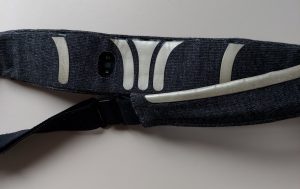
Figure 3. Muse Device
Some people have had difficulty putting on the Muse device and getting it to connect well at the sensor near the ears. I have thick hair and found a technique that works really well for me. I apply the muse around my neck, lean my head back, then pull the band up on the forehead and resting on top of the ears, just above the ear canal, I then move my ears out from under the band starting at the middle back of the ear. Moving the band into position behind the ears creates difficulty with keeping hair out of the way.
There are several different meditations (either guided or silent with sounds) offered for both daytime and sleep. The software has a proprietary algorithm that is used to determine if the mind is calm to active. The soundscapes have birds that chirp when you have reached a calm state and the background sounds get louder as you come out of the calm state. This is a trigger to refocus on your breath again to achieve the calm state. I really like this device and I was able to get to a deep meditative state during my second meditation. I am a practiced meditator, but I haven’t been at this level for quite a while. Some days my brainwaves are just noisier, See Figure 4. It’s important to not worry about that, but just accept and continue. I have found that a NuCalm session can quiet a noisy mind by using the NuCalm and then repeating the Muse meditation. So if you have times of “fibro fog”, otherwise known as “brain fog”, the NuCalm may be better to use.
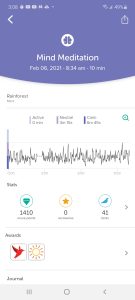
Calm state 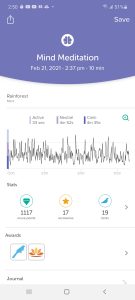
Noisier state
Figure 4. Example of Muse Mediation App Summary
Are you worried about the emf levels of these devices? Power and frequency are important, and in general, cell phones need to transmit further distances than Wi-Fi and bluetooth. I found this YouTube video helpful on the topic. Personally, I tend to use devices as needed, and turn everything off at night.
Stay tuned for next month’s blog when I cover nutrition.



